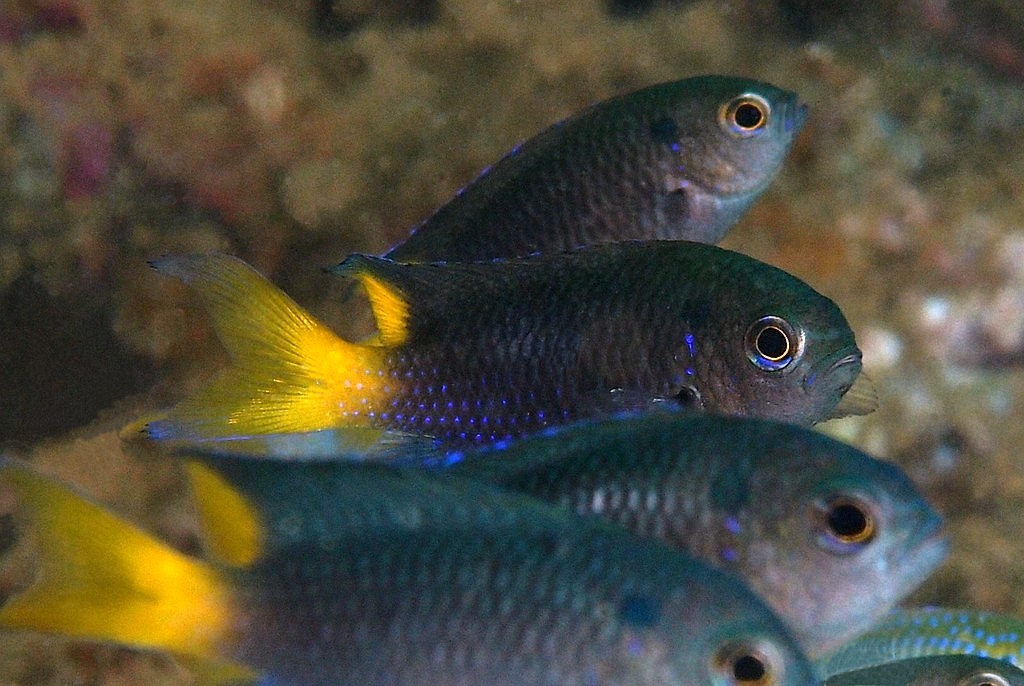NEOPOMACENTRUS VIOLASCENS - (BLEEKER, 1848)
Actinopterygii (Gigaclass) > Actinopteri (Class) > Teleostei (Subclass) > Blenniiformes (Order) > Pomacentridae (Family) > Pomacentrinae (Subfamily) > Neopomacentrus (Genus)
Demoisselle violette, Violet demoiselle, Violet damsel, Jeom-ja-dom, Sumire-suzumeda, スミレスズメダイ, 점자돔, 紫鋸雀鯛,
Synonymes
Dascyllus xanthurus (Bleeker, 1853)
Neopomacentrus violaceus (Bleeker, 1848)
Pomacentrus violascens (Bleeker, 1848)
Pristotis violascens (Bleeker, 1848)
-----------------------
Description
Dorsal spines (total): 13; Dorsal soft rays (total): 11-12; Anal spines: 2; Anal soft rays: 10-11; Lateral line scales: 15-17 tubed; Lobes of upper and lower caudal fin moderately elongated and sharp; Center of caudal fin deeply hollowed; Suborbital scaly; Hind margin of opercle crenulated or weakly serrate. Max. length: 7.5 cm TL. Depth range: 1 - 30 m, usully: 5 - 25 m.
Color
Dark brown with black shoulder spot, caudal peduncle and caudal fin yellow.
Etymology
Neopomacentrus: from Greek, neos = new + from Greek, poma = cover, operculum + from Greek, kentron = sting.
violascens: from Latin, violaceus = violet (colored). Referring to its violetish body color in life (dark brown in alcohol).
Original description: Pristotis violascens Bleeker, 1848 - Type locality: Bima, Sumbawa Island, Lesser Sunda Islands, Indonesia.
Distribution
Indo-West Pacific: East Andaman Sea, Indonesia, Philippines, Papua New Guinea, southeast to New Caledonia.
Biology
Adults are found in lagoons, harbors, and coastal reefs, shallow habitats, deep sand or mud slopes with outcrops of debris or coral rubble pieces, or on rocky substrates in sheltered bays. They usually occur in large aggregations, sometimes forming mixed aggregations with Neopomacentrus sp. Oviparous, distinct pairing during breeding. Eggs are demersal and adhere to the substrate. Males guard and aerate the eggs. Diurnal species.
Similar species
Neopomacentrus azysron (Bleeker, 1877) - Reported from New Caledonia.
Neopomacentrus bankieri (Richardson, 1846) - Reported from Western Pacific: Indonesia, east to New Ireland (Papua New Guinea), north to southern China, south to northern Australia.
Neopomacentrus cyanomos (Bleeker, 1856) - Reported from New Caledonia.
Neopomacentrus flavicauda (Fricke & Allen, 2021) - Reported from Red Sea; northwestern Indian Ocean: Gulf of Aden, Socotra (Yemen).
Neopomacentrus sororius (Randall & Allen, 2005) - Reported from Indian Ocean: East Africa (Mozambique, Tanzania, Kenya), Comoros and Madagascar, east to Sumatra (Indonesia).
Last update: 16, July 2023
Demoisselle violette, Violet demoiselle, Violet damsel, Jeom-ja-dom, Sumire-suzumeda, スミレスズメダイ, 점자돔, 紫鋸雀鯛,
Synonymes
Dascyllus xanthurus (Bleeker, 1853)
Neopomacentrus violaceus (Bleeker, 1848)
Pomacentrus violascens (Bleeker, 1848)
Pristotis violascens (Bleeker, 1848)
-----------------------
Description
Dorsal spines (total): 13; Dorsal soft rays (total): 11-12; Anal spines: 2; Anal soft rays: 10-11; Lateral line scales: 15-17 tubed; Lobes of upper and lower caudal fin moderately elongated and sharp; Center of caudal fin deeply hollowed; Suborbital scaly; Hind margin of opercle crenulated or weakly serrate. Max. length: 7.5 cm TL. Depth range: 1 - 30 m, usully: 5 - 25 m.
Color
Dark brown with black shoulder spot, caudal peduncle and caudal fin yellow.
Etymology
Neopomacentrus: from Greek, neos = new + from Greek, poma = cover, operculum + from Greek, kentron = sting.
violascens: from Latin, violaceus = violet (colored). Referring to its violetish body color in life (dark brown in alcohol).
Original description: Pristotis violascens Bleeker, 1848 - Type locality: Bima, Sumbawa Island, Lesser Sunda Islands, Indonesia.
Distribution
Indo-West Pacific: East Andaman Sea, Indonesia, Philippines, Papua New Guinea, southeast to New Caledonia.
Biology
Adults are found in lagoons, harbors, and coastal reefs, shallow habitats, deep sand or mud slopes with outcrops of debris or coral rubble pieces, or on rocky substrates in sheltered bays. They usually occur in large aggregations, sometimes forming mixed aggregations with Neopomacentrus sp. Oviparous, distinct pairing during breeding. Eggs are demersal and adhere to the substrate. Males guard and aerate the eggs. Diurnal species.
Similar species
Neopomacentrus azysron (Bleeker, 1877) - Reported from New Caledonia.
Neopomacentrus bankieri (Richardson, 1846) - Reported from Western Pacific: Indonesia, east to New Ireland (Papua New Guinea), north to southern China, south to northern Australia.
Neopomacentrus cyanomos (Bleeker, 1856) - Reported from New Caledonia.
Neopomacentrus flavicauda (Fricke & Allen, 2021) - Reported from Red Sea; northwestern Indian Ocean: Gulf of Aden, Socotra (Yemen).
Neopomacentrus sororius (Randall & Allen, 2005) - Reported from Indian Ocean: East Africa (Mozambique, Tanzania, Kenya), Comoros and Madagascar, east to Sumatra (Indonesia).
Last update: 16, July 2023
